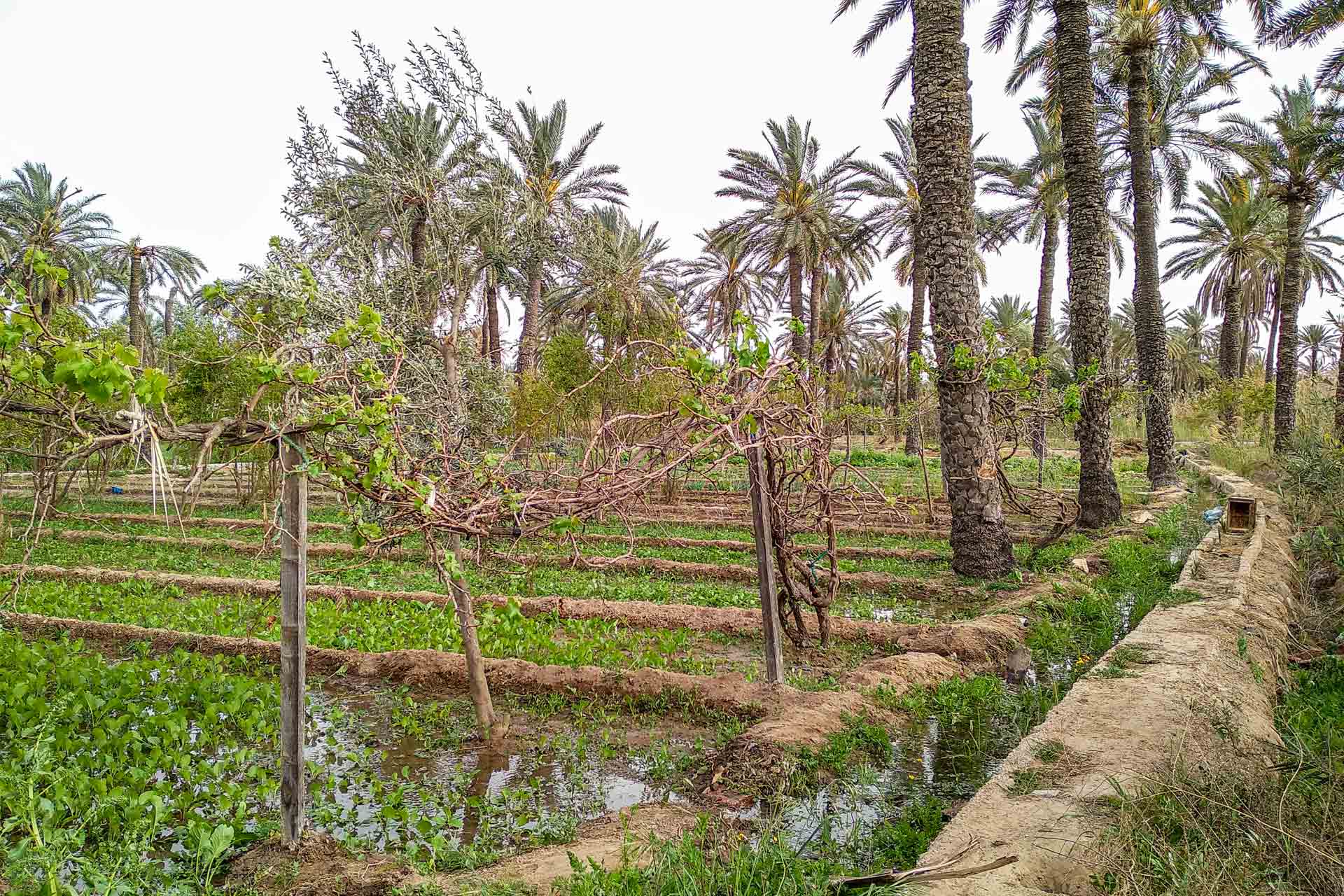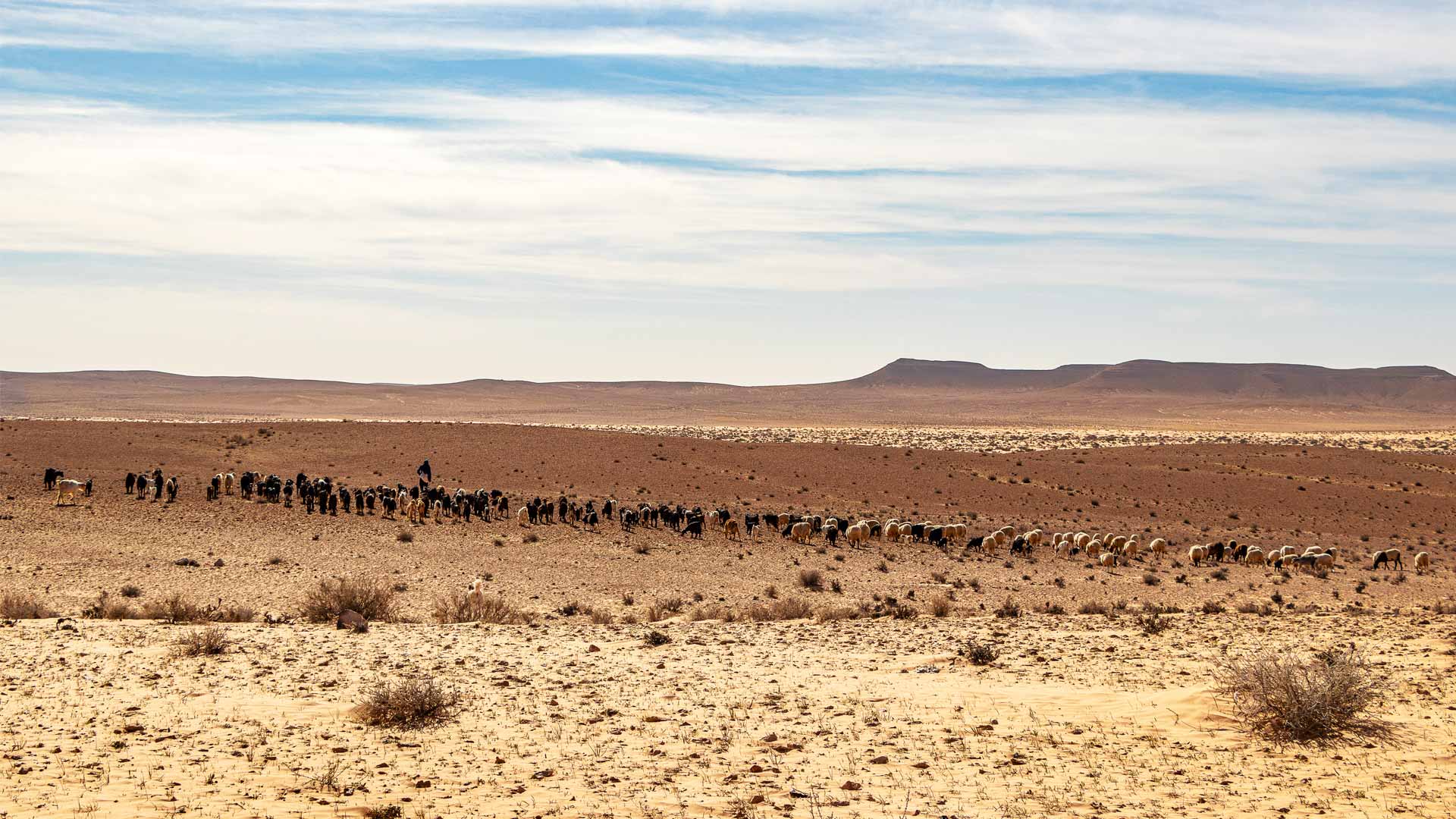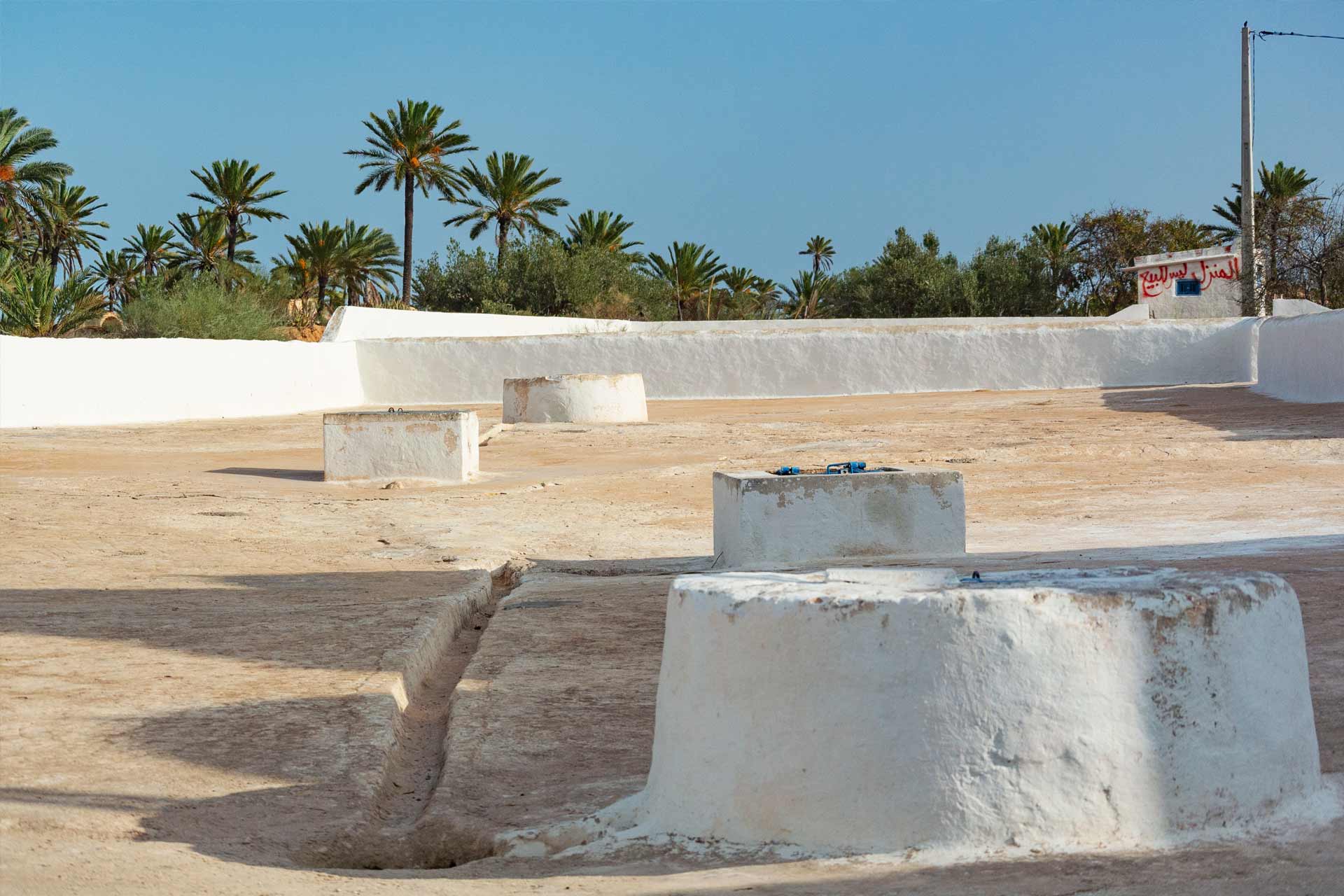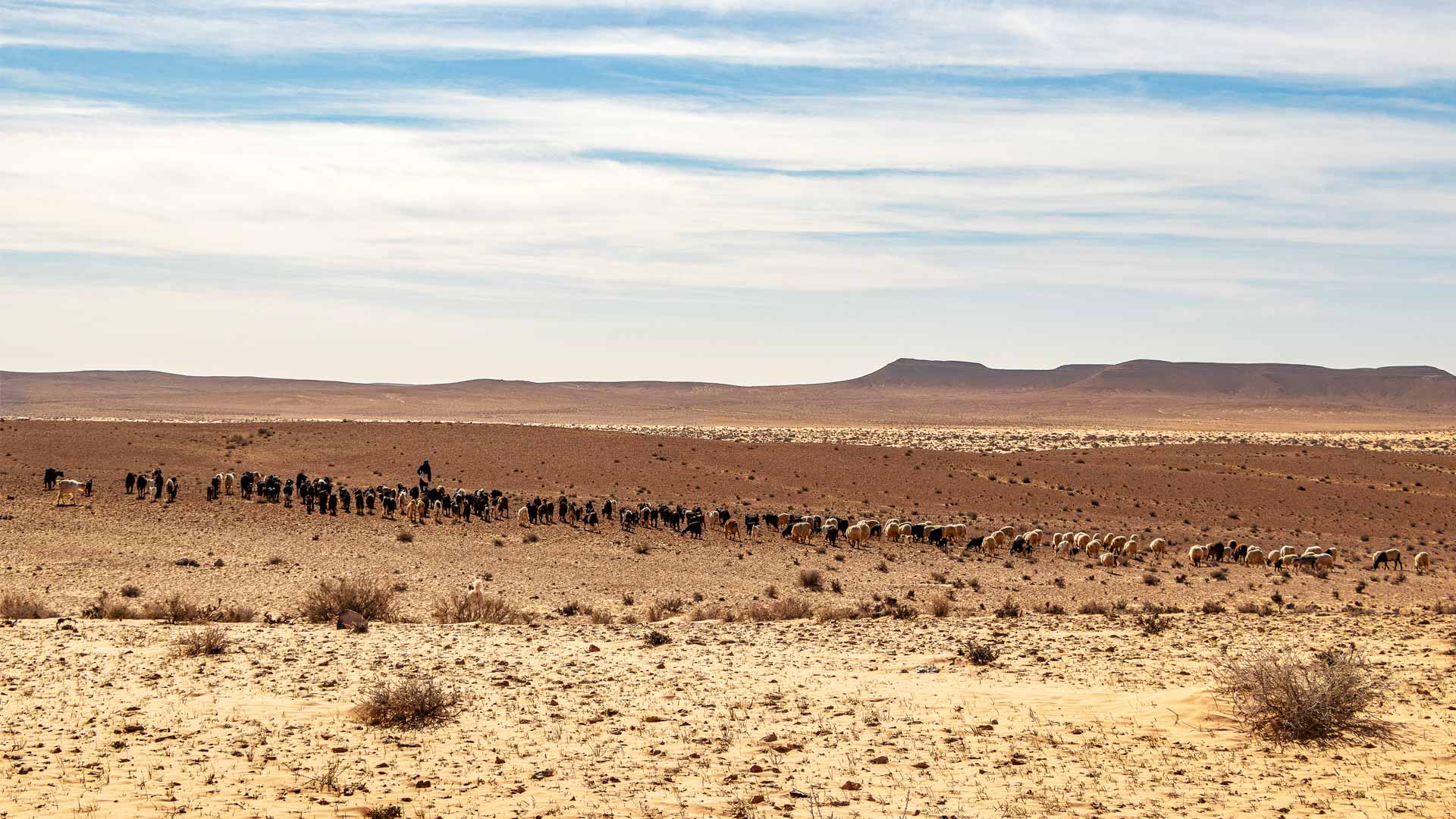In the southwestern town of Tamaghza, 70-year-old Houssine has been waiting patiently. This farmer owns half a hectare of land in the mountain oasis. Houssine has always lived in Tamaghza where he grows dates, pomegranates, and vegetables.
After a while, his neighbor called out to him. "Your turn has finally come!", he shouted. The latter opened his Saguia* with a pickaxe stroke and water started streaming towards Houssine's land. "Thankfully, water is free for everyone here", he said with a grin, "otherwise, I don't know how we would survive". One by one, each farmer clears the way for water to flow through the entire oasis, without any compensation whatsoever.
Here and in other parts of Tunisia, such as the oasis of Jemna and Zaafrane, the springs of Tozeur, Gafsa and Gabes, and in the heart of the arid and semi-desert steppes of Dhaher, resources are shared and land is still managed by tribes and spared from privatization. In these oases and places, water and other resources are still considered as common goods.
In a big part of Tunisia, individual property is still a "novel" concept. Many regions are governed by social structures that use an asset and resource management system that is quite different from the individual property concept. As such, the "commons" - which is a concept for self-managed resource governance - are still prevalent.
The concept of the commons has been present in Tunisia for thousands of years. The Arab conquests in the region were what gave it its contemporary form. This can also be said about other places throughout North Africa, the Middle East and the Arabian Peninsula in Saudi Arabia and Yemen, such as the Nile in Egypt, or the Tigris and Euphrates rivers in Syria and Iraq.
This modus-operandi corresponds to the definition of the commons as described by Elinor Ostrom. She was an American political economist who, along with Oliver Williamson, won the Nobel Prize in economics for her analysis of economic governance, and in
particular, the commons. According to her, a commons and commons management must comply with the following principles:
1) Commons need to have clearly defined boundaries;
2) Rules should fit local circumstances;
3) Participatory decision-making is vital;
4) Commons must be monitored;
5) Sanctions for those who abuse the commons should be graduated;
6) Conflict resolution should be easily accessible;
7) Commons need the right to organize;
8) Commons work best when nested within larger networks.

Irrigated plot in the Chenini oasis, Gabes. Photo credits : Ernest Riva
Collectively managed land
For the past decade, 65-year-old Noureddine, a former secondary school inspector, has spent most of his days on his plot of land in northern Gafsa. He irrigates, works the land, and takes care of his plants. At the top of the hill, vast agricultural lands stretch as far as the eye can see. The towering mountain of Orbata, known for having served as a refuge for Lazhar Chraiti* and his companions during the armed struggle against the French colonizer, can be seen in the distance.
"This whole land used to be ours", says Noureddine, "I still remember when I was young, I used to roam these lands at the crack of dawn with our animals, herds of sheep and camels".
According to Abdelmajid Fourati, Chairman of the Collective Land Council of the tribe of "Ouled Chrait", the tribe's land represents almost 4000 hectares of agricultural land in northern Gafsa. Historically, they were managed collectively. Even though the lands surrounding the douars* and the houses were privately owned, the rest, and particularly the grazing lands, were controlled by the tribe and the community.
This management was carried out according to the hierarchy within the tribe which would appoint a "Majles" or council whose mission was to demarcate the land and divide it among the local and surrounding tribes. This was done to minimize potential conflicts between neighboring tribes or within the same clan. The very notion of a commons implies a fair share for all. Should a dispute arise, the chiefs had to convene in order to work out fair solutions for the good of the communities and to keep conflicts to a minimum.
This whole system was governed by the rules of Islam as well as the customs of the tribe so as to ensure that everyone had enough to eat. If sanctions were imposed - usually for theft or failure to pay the Zakat* - the punishment was collective and could be as severe as social exclusion.
Just a little further south, in the Governorate of Medenine, the Dhaher plain expands wide on open horizons, between the city of Gabes and Libya. For a long time, this so-called "desert" plain was an invaluable grazing area for the nomadic and semi-nomadic tribes of southern Tunisia who used to roam this territory. For hundreds of years, this plain has been the place of transhumance of the Berber and Arab tribes.At the time, the notion of private property was not yet established and the lands were collectively managed within the same tribe, following their customs and traditions.
The different tribes coexisted, with clearly defined boundaries between their grazing lands.
People’s access to the land was not defined by ownership but rather by use rights. Everyone could use and benefit from the land without having the right to sell or transfer it to another person. This is the very origin of the meaning of a common good.
Common goods: These goods are characterized by collective use rights and should in no case become subject to private ownership. Common goods are therefore inalienable.
Commons: Social practices and processes that people engage in as they cooperate, with the intent of managing resources in an equitable and sustainable manner.
Collective ownership: The property is characterized by both collective use rights and private ownership, and can therefore be divided and sold between the different owners.

Tribal land for grazing, Dhaher region, Kebili. Photo credits : Ernest Riva
Collective water management
On the island of Djerba, rectangular foundations border the roads alongside the mosques. "Sabiles", as a local imam called them, are rainwater collection structures that allow passers-by and residents to drink and to give water to their animals. "Some of them are still functional", he commented.
In the words of the Imam, these Sabiles are donations made by the wealthy to the mosque. Even though these structures supposedly belong to the mosque, water is a common good that belongs and is available to everyone.
In Arabic, the word Sabile means "path or passage" and can also be used to refer to a structure or a building which is offered as a gift to the community or, in our case, to the provision of free water for passers-by.
These age-old traditions of sharing have been threatened and in some cases even abolished. Individual ownership of property was first introduced during colonization before being promoted by post-independence States. This individualization process was first initiated in 1881 through the enforcement of the cadastre (land register) and was then pursued by the Tunisian government. In 1898, a colonial decree ordered the annual transfer of 2000 hectares to the "Beylik" (Bey's properties), dealing with the "Habous" lands in the same way. President Habib Bourguiba then proceeded to abolish the "waqf" on July 18, 1957. This decision came as a result of state procedures to dispossess parts of the population and control their various land resources.
Such measures can be regarded as the logical next step within a liberal system which continuously promotes individual achievement. This system is at odds with the commons which defends a balanced approach to resource governance while taking the interest of the community into consideration.
In the Muslim world,
"waqf" ou
"habous” are donations, made by a person as an act of charity, towards social or religious projects such as schools, hospitals and mosques. A group of people are thereupon designated to manage it.
On March 19 1874, a decree was issued that marked the establishment of the waqf association "djam'iyat al-awqâf" and would ensure the management of these projects. In the mid-19th century, one-third of the cultivated land in Tunisia was classified as
a
"habous", as well as the
"zaouias", mosques, schools, and hospitals. The Aziza Othmana hospital in the medina of Tunis is also a
"habous".

"Sabil" in Midoun region, Djerba. Credit photos : Ernest Riva
What is left of the commons?
In the Governorate of Tozeur, the oasis of Tamaghza has been the birthplace of multiple civilizations in Tunisia. To this day, this oasis constitutes both a water resource and a farming area for the nomadic, semi-nomadic, and sedentary tribes, as it does for Houssine, a farmer of the region.
"Water here is free for everyone! It has always been and always will be!" said Mohamed, a member of the local development group in Tamaghza.
This is a distant reality for many Tunisian farmers who are striving to gain access to water across the country. Several Agricultural Development Groups (ADGs) and water associations are facing a significant budget deficit due to the rising cost of water and electricity. Climate change has also had a significant impact on the drying up of water sources.
Tunisia's oases enjoy a long tradition of joint water distribution, which was not under any ownership. Passing through Tozeur,from Gafsa to Gabes, elderly people often reminisce about a time when water used to flow naturally and was distributed based on the needs of each person and the size of their land.
"Our parents and grandparents have never paid for water. The oasis waters flowed from the spring to the wadi and ran through all the plots of land where everyone had their share based on the needs of their crops," explained Zakaria Hechmi, a seed farmer in the Chenini oasis in Gabes.
This ancient water management and distribution system ensured equity for everyone through the main Saguia that crossed the oasis and the secondary Saguia that allowed for the lands to be irrigated. Each individual's share was determined according to the surface area of the land that needed to be irrigated (in Chber* or cubic centimeters of water). Based on this, water passed through the "Saguia" for the required amount of time.
"There was a time when we all had the right to water. We didn't buy it but we had access to it," explains Ammar, a farmer who owns two hectares of land. "Everyone was entitled to their share".
In fact, each person received water at a certain time during the day, based on the surface area of the land. This system was maintained by the elders, whose knowledge and know-how were widely recognized, and who made sure that the water was distributed in a fair manner. Due to the respect they held, their say in the social structure of the oasis went unchallenged.
A sanctioning system was also put in place. Those who obstructed the process or kept their Saguia open longer than permitted could face social sanctions and lose the trust of their peers.
And so, beyond its common management, this concept was crucial in creating, maintaining and dividing the community.
Today, in the area around the Gabes oasis, water is handled by an agricultural development group (ADG) that oversees the management of water resources. This water flows into concrete Saguias that irrigate, at a set time, each part of the land. Watering hours are recorded by the ADG and the users pay their contribution accordingly. The farmers are therefore individualized and in a place where water used to be shared without compensation, the richest now dig their own wells. A few areas remain where the communal system is still in use, such as Tamaghza, Houssine’s hometown.
For centuries, the commons have played an important role in Tunisia. Though conflicts over resources have arisen between groups and tribes, the ancestral know-how of these groups has evolved with the notion of the commons, which has taken different shapes and forms across the world.
The commons have therefore persisted and evolved throughout the centuries. Today, new norms have come into place in relation to the commons: a more even-handed justice system, the acknowledgment of women’s role in commons stewardship, etc. But the aim has not changed: ensuring the preservation, sustainability, and fair governance of resources, even if this implies financial compensation.
There are plenty of stories and examples of the commons in Tunisia. Many myths exist around the abundant resources and the ancient justice system, which was believed to be more just. Evidence of this way of life can be found in ruins and remnants still exist in the arid lands of the south, where communities continue to resist individualism and private ownership.




